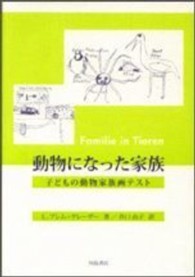Full Description
This user-friendly resource defines formative assessment and provides strategies for embedding formative assessment into the K-8 science curriculum. Based on the IDEA approach: Introduce, Discuss, Elaborate, and Apply this research-based book guides readers through discussions, 'thought and reflection' activities, analyses of assessment techniques, and applications to classroom practice. Formative Assessment Strategies for Enhanced Learning in Science, K-8 demonstrates how teachers can use various models of formative assessments to instruct, monitor student progress, and evaluate learning, helping to broaden teachers' understanding of assessment and how assessment tools can be used to guide successful standards-based teaching and learning in science. To support teachers' application of formative assessments in the classroom, the author covers:"a framework for planning and implementing high quality instruction and formative assessments "planning guides with examples and suggestions for differentiating instruction"rubrics as a means of discovering student strengths and weaknesses"additional specific tools for collecting student data to inform instructional decisions
Contents
PrefaceThe Goals of Formative Assessment Strategies for Enhanced Learning in ScienceUses for Formative Assessment Strategies for Enhanced Learning in ScienceAcknowledgmentsAbout the AuthorIntroductionStudent-Centered Instruction and AssessmentChanging Practice to Improve LearningAn Overview of Chapters1. Formative Assessment and ScienceNew Ways of Thinking About AssessmentGoal-Centered AssessmentResearch Support for Formative AssessmentCreating a Vision for Formative AssessmentExamining Beliefs and PracticesTraditional Versus Student-Centered Views of AssessmentFormative Assessment as "Authentic" AssessmentClear Targets for Instruction and Assessment2. Using Rubrics to Guide LearningThe What and Why of RubricsHolistic RubricsDesigning Holistic RubricsGeneralized RubricsExamples of Generalized RubricsAnalytic RubricsAssessment Tasks With Analytic RubricsDesigning Analytic RubricsRubrics for Self-Assessment and Peer AssessmentDesign a Rubric3. Observation Checklists and Effective QuestioningObservation ChecklistsSample Observation ChecklistsEffective QuestioningQuestions for Thinking and Problem SolvingQuestions for Instruction and Assessment4. Notebooks, Reports, and Graphic OrganizersNotebooksNotebooks as Assessment ToolsRubric for a Science NotebookLab ReportsLab Reports for Learning and AssessmentRubric for a Lab ReportGraphic OrganizersDescriptive OrganizersSequential OrganizersProcess-Casual OrganizersCategorical OrganizersComparison-Related OrganizersProblem-Solution OrganizersFour Corner Organizers5. Projects and PresentationsLearning Through ProjectsAssessing ProjectsRubric for a ProjectLearning Through PresentationsAssessing Presentations6. Performance Tasks and Embedded AssessmentsPerformance AssessmentPerformance TasksA Generalized Rubric for a Performance TaskEmbedded AssessmentsA Model for Embedded AssessmentsSample Embedded Performance TaskDesigning Embedded Performance AssessmentsPerformance Assessments Following InstructionSample Performance AssessmentsPerformance Assessment as Benchmark AssessmentCharacteristics of Benchmark AssessmentsSample Benchmark Assessment7. Planning and Implementing Formative AssessmentCharacteristics of High-Quality Instruction and AssessmentPlanning Formative AssessmentA Planning Guide for Formative AssessmentA Planning Guide for a Unit on CellsUsing Assessment Data to Modify InstructionProject ChoicesAdjusting AssignmentsStations for Active LearningDifferentiating Instruction Through CentersCreating ContractsFormative Assessment and AccountabilityReferences and Further ReadingIndex







